In today’s increasingly digital business landscape, cyberattacks have evolved in both scale and sophistication. Among them, phishing has become a primary weapon of choice for cybercriminals, often targeting unsuspecting employees through deceptive emails and communications. To effectively counter this threat, organisations must invest in both simulated phishing tests and comprehensive cybersecurity awareness training.
This blog explores how phishing tests work, why training matters, and how a combined approach helps organisations reinforce their human firewall.
Modern Cyber Threats: The Ever-Changing Battlefield
Gone are the days when cybersecurity concerns were limited to IT teams. With the growing use of cloud platforms, mobile workforces, and digital communications, every employee now plays a role in securing company data.
Phishing attacks mimic trusted communications, luring users into clicking malicious links, revealing credentials, or downloading harmful files. These attacks are cheap to produce and easy to scale, making them a persistent risk. Employee training, including cyber security training for employees and mock phishing exercises, are now essential defences—not just technical barriers.

What Are Phishing Tests and How Do They Work?
Phishing tests are controlled simulations created to mimic real-world phishing attempts. Their purpose is to evaluate how employees respond to suspicious emails, links, or files. These tests are a proactive strategy to identify potential weaknesses in your organisation’s human defences.
Common formats include:
- Spoofed emails posing as colleagues, clients, or IT support
- Fake messages urging password resets or document reviews
- Simulated business updates requiring urgent action
When conducted correctly, these tests serve as an educational tool—highlighting what to look out for and how to respond securely.
Essential Elements of Effective Phishing Tests
Not all phishing tests are created equal. For maximum impact, a phishing test should:
- Use real-world scenarios: Messages should closely resemble genuine phishing attacks.
- Vary in complexity and frequency: Employees should be challenged regularly but not overwhelmed.
- Provide immediate feedback: If someone clicks a suspicious link, show what went wrong and how to handle it better next time.
These tests also deliver key insights such as click-through rates, report rates, and repeat offenders—helping shape future training.
Why Phishing Tests Alone Aren’t Enough
While phishing tests are useful, they’re just one piece of the puzzle. Employees who fail a test may lack the broader knowledge to improve behaviour. Without ongoing training, simulations become repetitive and ineffective.
A strong cybersecurity strategy requires layered learning, including hands-on training, regular updates, and tools that reinforce safe digital behaviour—especially against evolving phishing techniques.
Cybersecurity Awareness Training: What It Is and Why It Matters
Cybersecurity awareness training teaches employees to identify, prevent, and report cyber threats. It goes beyond phishing to cover topics like data protection, secure browsing, mobile security, and password hygiene.
An effective programme often includes:
- Scenario-based learning
- Role-specific modules (e.g., finance teams receive training on invoice fraud)
- Bite-sized content for ease of understanding
- Reminders and micro-training over time
The aim is to build confidence, not fear—empowering staff to take ownership of their digital actions.
Implementing a Successful Training Programme
For training to resonate, it must be:
- Clear and engaging: Avoid overloading users with technical terms.
- Ongoing: Cyber threats change. So should your training.
- Interactive: Encourage users to ask questions, take quizzes, or participate in workshops.
Additionally, gamifying cybersecurity training for employees—through scores or progress trackers—can increase participation and retention rates.
Creating a Culture of Cyber Vigilance
Cybersecurity isn’t just about tools or training—it’s about attitude. Building a culture of security starts with leadership setting expectations and ends with each employee understanding their role.
This culture thrives when staff:
- Know they won’t be blamed for reporting honest mistakes
- Have access to trusted security resources
- Are encouraged to share suspicious findings
One important resource is the best password management software, which supports safer login practices and reduces the burden of remembering multiple credentials. Making such tools accessible shows employees that security can be both simple and smart.
How to Measure Training Effectiveness
Tracking your cybersecurity awareness efforts is critical. But how do you know it’s working?
Key performance indicators include:
- Phishing test failure rates (and improvement over time)
- Engagement metrics (e.g., training completion rates)
- Reduction in real incidents caused by human error
- Frequency of employees reporting suspicious activity
Review these metrics quarterly, adjust the content accordingly, and celebrate improvements. Cybersecurity isn’t a one-off task—it’s an ongoing investment.
Linking Password Security with Phishing Prevention
Many phishing attacks aim to harvest login details. Weak passwords or reused credentials can quickly compromise an entire network. That’s where promoting secure password habits makes a difference.
Using the best password management software:
- Minimises the risk of password reuse
- Generates complex, unique passwords
- Offers secure autofill options to reduce human error
Including password best practices in your training programme adds an important layer of defence. When paired with phishing simulations, this approach drastically reduces the risk of data breaches due to social engineering.
Avoiding Common Mistakes
Even well-intended awareness efforts can fall flat if mismanaged. Common missteps include:
- One-time training: Cybersecurity is an evolving field—training must be ongoing.
- Overcomplication: Avoid filling sessions with jargon or tech-heavy language.
- Neglecting feedback: Failing to adjust based on employee responses or test outcomes hinders improvement.
Focus on simplicity, repetition, and continuous learning for long-term success.
Conclusion: Empower Your People, Secure Your Business
Phishing tests and cybersecurity awareness training are both critical tools in a company’s defence against digital threats. When used together, they create a powerful framework for identifying vulnerabilities, educating employees, and fostering a workplace culture of vigilance and responsibility.
Tools such as the best password management software and regular cybersecurity training for employees amplify this strategy, ensuring protection is both comprehensive and practical.
At the end of the day, your people are your strongest defence—and when empowered with knowledge, they can prevent the majority of threats before they even begin.
Renaissance Computer Services Limited is committed to supporting businesses in building a resilient and well-informed workforce that champions cyber safety at every level.








